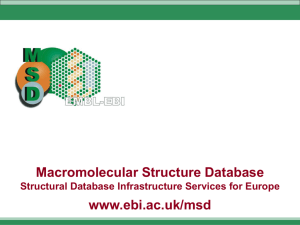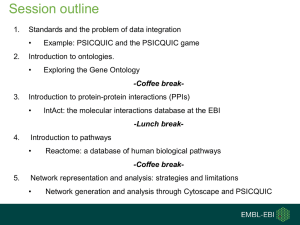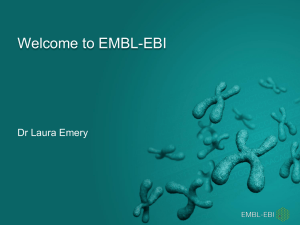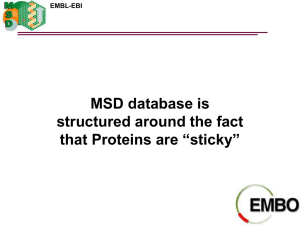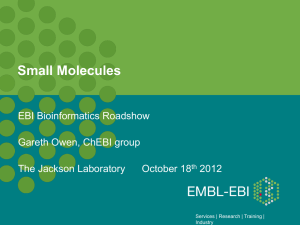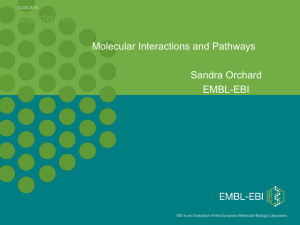Presentation
advertisement
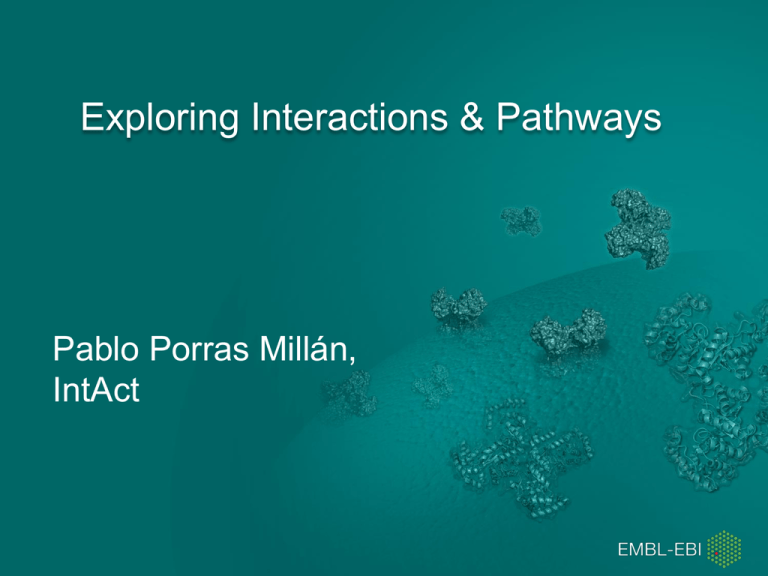
Exploring Interactions & Pathways Pablo Porras Millán, IntAct Session outline 1. An example of an interaction database: IntAct hands-on. 2. A manually-curated pathway database: Reactome hands-on. EMBL-EBI IntAct: The molecular interactions database at the EBI www.ebi.ac.uk/intact IntAct – Home Page EMBL-EBI IntAct webpage-based search EMBL-EBI IntAct webpage-based search Details of interaction Choice of UniProtKB or Dasty View EMBL-EBI IntAct: changing the layout EMBL-EBI IntAct: download formats EMBL-EBI Interaction detail in IntAct EMBL-EBI Detailed participant information: Dasty view EMBL-EBI IntAct: filtering results EMBL-EBI IntAct: visualizing results as a network EMBL-EBI IntAct: using lists EMBL-EBI IntAct: browse menu EMBL-EBI IntAct: advanced search ... EMBL-EBI IntAct: MIQL syntax search EMBL-EBI Reactome tutorial Reactome Tools • Interactive Pathway Browser • Pathway Mapping and Over-representation • Expression overlay onto pathways • Molecular Interaction overlay • Biomart EMBL-EBI Front Page http://www.reactome.org Sidebar Navigation bar Main text EMBL-EBI Exercise 1 …see the Tutorial handouts EMBL-EBI The Pathway Browser Species selector Diagram Key Sidebar Zoom/move toolbar Pathway Diagram Panel Details Panel (hidden) Thumbnail EMBL-EBI Pathways tab – pathway hierarchy Pathway Reaction Black-box EMBL-EBI Exercise 2 …see the Tutorial handouts From the homepage, search for ‘PDGF signaling’. Click on the top pathway hit. This will open it in the Pathway Browser. Ignoring the diagram for now, look at the Pathways tab on the left. 1. How many sub-pathways does this pathway have? 2. How many reactions are in the first of these sub-pathways? 3. What reaction follows ‘Processing of classical PDGFs’? Hint: If it’s not visible, open the Details pane at the bottom of the page by clicking on the blue triangle. EMBL-EBI The Pathway Browser - Pathway Diagrams Boxes are proteins, protein sets, mixed sets or complexes. Ovals are small molecules (or sets of) Green boxes are proteins or sets, blue are complexes. Regulation +ve -ve Input Reaction node Catalyst Outputs Compartment Transition Binding Dissociation Omitted Uncertain EMBL-EBI Exercise 3 …see the Tutorial handouts EMBL-EBI Navigating in the Pathway Browser I Home and Analyze buttons Click here Highlights Details here Click here to open pathway diagram... EMBL-EBI Navigating in the Pathway Browser II Click here Zoom Highlights Details here EMBL-EBI Exercise 4 …see the Tutorial handouts EMBL-EBI The Details Panel EMBL-EBI Exercise 5 …see the Tutorial handouts 1. Find the reaction ‘Activated type I receptor phosphorylates SMAD2/3 directly’. What pathway does it belong to? 2. In which cellular compartment does this reaction take place? 3. What is the associated GO molecular function? 4. What references verify this reaction? 5. Is this reaction predicted to occur in Canis familiaris? In Saccharomyces cerevisiae? EMBL-EBI Pathway Analysis EMBL-EBI Pathway Analysis – Overrepresentation P-val Reveal next level ‘Top-level’ EMBL-EBI Exercise 6 Use data file from earlier exercises… Copy, and paste into submissions box… Check this! 1. What is the top ‘top-level’ pathway for this dataset? 2. How many genes are in this pathway, and how many were represented in the dataset? 3. Why is the top-level pathway ‘Signal transduction’ higher in the list than ‘DNA repair’, when the latter has a more significant probability score? (Hint - use the Open All button) EMBL-EBI Species Comparison I EMBL-EBI Species Comparison II Yellow = human/rat Blue = human only Grey = not relevant Black = Complex EMBL-EBI Exercise 7 …see the Tutorial handouts Launch Species Comparison and select the species Rattus norvegicus. When the results are displayed, open the pathway ‘Membrane trafficking’. 1. Find VAMP7 (top right of diagram) - what colour is it and why? 2. Which other species are inferred to have this protein? Hint: You can answer this question without re-running Species comparison. 3. Find CHMP7 (top middle) - why is it blue? 4. Find AP-1 Complex (top middle, a bit to the right, below CHMP7) Why is it black? How many proteins contribute to this object? Are they all predicted to exist in Rattus norvegicus? 5. Why is ADP grey? EMBL-EBI Expression Analysis I EMBL-EBI Expression Analysis II ‘Hot’ = high ‘Cold’ = low Step through Data columns EMBL-EBI Exercise 8 Launch Expression Analysis and load the example dataset. Click ‘Analyse’. When the results are displayed, find the pathway ‘DNA replication’. 1. How many proteins are in this pathway? 2. How many had expression data? Click on the View button to see this pathway in the Pathway Browser and then go to the ‘Regulation of DNA replication’ subpathway. Use the Experiment Browser toolbar to cycle through the timepoints. 3. Which protein has the greatest change of expression? 4. Find the complex ‘Orc4:Orc5:Orc3:Orc2:origin’ (top left of the diagram). Which component of the complex has the lowest expression at 24h? 5. What was the probe ID used to measure expression of this component? EMBL-EBI Molecular Interaction Overlay EMBL-EBI Exercise 9 …see the Tutorial handouts Open the Pathway Diagram for ‘Netrin-1 Signaling’. 1. Find the protein PTPN11 (top left of the plasma membrane). Right click on it and select Display Interactors. How many are there? 2. How many times has the interaction between PTPN11 and A7MD36 (UniProtKb for GAB2) been documented? Hint: This detail is not in Reactome. 3. Find the protein SRC (just to the right of PTPN11). Display interactors for this protein. How many are there? Can you get a list of them? 4. What is the easiest way to remove interactors? EMBL-EBI BioMart – selecting your dataset EMBL-EBI BioMart – filters EMBL-EBI BioMart – attributes Check to get attribute EMBL-EBI BioMart – results EMBL-EBI Exercise 10 EMBL-EBI The Reactome Pathways Portal (Beta) EMBL-EBI Protein structures from PDBe EMBL-EBI Chemical structures from ChEBI EMBL-EBI Expression data from the Expression Atlas EMBL-EBI Interaction Data from IntAct EMBL-EBI More about Reactome Reactome User's Guide http://wiki.reactome.org/index.php/Usersguide EMBL-EBI Websites & Tools • IntAct – www.ebi.ac.uk/intact • PSICQUIC view – www.ebi.ac.uk/Tools/webservices/psicquic/view • Reactome – www.reactome.org EMBL-EBI Acknowledgements Group leader Supported by the European Community's Seventh Framework Programme (FP7/2007-2013) under grant agreement for Affinomics (FP7-241481). Henning Hermjakob Coordinator Sandra Orchard Curation team Margaret Duesbury Birgit Meldal Steve Jupe Antonio Fabregat Bijay Jassal Phani Garapati David Croft Developing team Rafael Jiménez Marine Dumousseau Noemí del Toro EMBL-EBI
